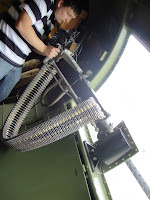It's been a little while since my last post and so much has happened! Where should I start? Lets see... Finals are over, took my commercial FAA pilot written test, have had several flights, including first solo in a complex aircraft, and a crash not far from here.
Lets start with the crash and go from there. In writing this I mean no disrespect to the family and friends of the pilot. My condolences go out to them.
On December 3rd, a private pilot with an instrument rating was attempting to land at the Ogden airport on an instrument approach. He crashed short of the runway knocking out power to hundreds of homes and damaging 2 homes. Read the news report HERE.
Also, a preliminary NTSB report can be read HERE.
Looking at the report and and reviewing what happened we can make a few guesses and conclusions. The two arrows shown in the first picture show Ogden Airport and the approximate spot and direction of the crash.
The next diagram is the approach that was used by the pilot. The report stated that visibility was 1/2 mile and the ceiling was 100ft. It also stated that it was worse on the ground. The ATIS information had a ceiling at 400 ft. Near the bottom of this approach is a minimums section. It states for a straight in approach on runway 3 that you need AT LEAST 3/4 mile visibility and a 200 ft ceiling, the conditions this day ,at the time of his approach,were close to or even below minimums.
Last I have heard the pilot was in the hospital with burns over most of his body, but is expected to recover. ___________________________________________
To change the subject now, Finals are completed and this semester is over! It feels great to be done with this one and another step closer to my degree and career! I also took my FAA Commercial Pilot written test and I PASSED! It was 100 questions long and took me a little over 1 hr. If you would like to take a 10 question practice test on the commercial pilot questions, go HERE.
I have also had several flights in the Arrow. I have been practicing the same commercial maneuvers and feel more proficient in them. I am feeling much more comfortable in the arrow and am able to nail a spot on the runway within about 20 feet. I am really starting to enjoy flying the arrow, it feels more like flying an airplane than the Diamond DA40 did, don't get me wrong, I enjoy both for different reasons.
One of my flights I completed recently was my first solo in the Arrow. When transitioning to complex aircraft a major problem that can arise is not putting the landing gear down when landing. I was a little nervous that something like this could happen. But I stuck to my checklists and the entire flight went great. A few days before this flight I read an article in AOPAs Flight Training Magazine. The article told a story of a pilot who had gone up with an experienced instructor to freshen up on his skills. The instructor had him fly low. 700 feet above a river he flew overhead and followed the river in its twists and turns. The student said this experience felt more like flying than the usual straight and level flight and the doldrums of checking instruments. Motivated by this article, I decided to take advantage of my time alone in the aircraft and do something that I wanted to do. So after practicing a few maneuvers, I took the plane down to 700 feet AGL and followed a little river along all its twists and turns, some of which were very tight. I enjoyed the feeling of handling the aircraft and making my inputs to get the desired outcome. The feeling of changing G forces kept me aware of how tight the plane was turning. It was a great feeling completing that and being able to maintain my altitude.
Picture below shows river area I followed.
15 years ago

































